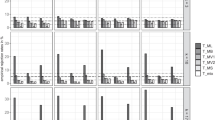Abstract
Ten empirical models of travel behavior are used to measure the variability of structural equation model goodness-of-fit as a function of sample size, multivariate kurtosis, and estimation technique. The estimation techniques are maximum likelihood, asymptotic distribution free, bootstrapping, and the Mplus approach. The results highlight the divergence of these techniques when sample sizes are small and/or multivariate kurtosis high. Recommendations include using multiple estimation techniques and, when sample sizes are large, sampling the data and reestimating the models to test both the robustness of the specifications and to quantify, to some extent, the large sample bias inherent in the χ 2 test statistic.
Similar content being viewed by others
References
Andreassen T.W., Lorentzen B.G., Olsson U.H.: The impact of non-normality and estimation methods in SEM on satisfaction research. Qual. Quant. 40, 39–58 (2006)
Arbuckle J.L.: AMOS 7.0 User’s Guide. SPSS, Inc., Chicago, IL (2006)
Barrett P.: Structural equation modeling: adjudging model fit. Pers. Individ. Differ. 42, 815–824 (2007)
Baumgartner H., Homburg C.: Applications of structural equation modeling in marketing and consumer research: a review. Int. J. Res. Mark. 13(2), 139–161 (1996)
Beran R., Srivastava M.S.: Bootstrap tests and confidence regions for functions of a covariance matrix. Ann. Stat. 13(1), 95–115 (1985)
Bollen K.A., Stine R.A.: Bootstrapping goodness-of-fit measures in structural equation models. Sociol. Methods Res. 21(2), 205–229 (1992)
Browne M.W.: Asymptotically distribution-free methods for the analysis of covariance structures. Br. J. Math. Stat. Psychol. 37, 62–83 (1984)
Chan W., Yung Y.-F., Bentler P.M.: A note on using an unbiased weight matrix in the ADF test statistic. Multivar. Behav. Res. 30(4), 453–459 (1995)
Choo S., Collantes G.O., Mokhtarian P.L.: Wanting to travel, more or less: exploring the determinants of a perceived deficit or surfeit of personal travel. Transportation 32(2), 135–164 (2005)
Chou C.-P., Bentler P.M.: Estimates and tests in structural equations modeling. In: Hoyle, R.H. (eds) Structural Equation Modeling: Concepts, Issues, and Applications, pp. 37–55. Sage, Thousand Oaks (1995)
Collantes G.O., Mokhtarian P.L.: Subjective assessments of personal mobility: what makes the difference between a little and a lot?. Transport Policy 14(3), 181–192 (2007)
Curran P.J., West S.G., Finch J.F.: The robustness of test statistics to non-normality and specification error in confirmatory factor analysis. Psychol. Methods 1(1), 16–29 (1996)
Enders C.K.: Applying the Bollen-Stine bootstrap for goodness-of-fit measures to structural equation models with missing data. Multivar. Behav. Res. 37(3), 359–377 (2002)
Fouladi, R.T.: Covariance structure analysis techniques under conditions of multivariate normality and nonnormality—modified and bootstrap-based test statistics. Paper presented at the Annual Meeting of the American Educational Research Association, San Diego, CA, April (1998)
Golob T.F.: Structural equation modeling for travel behavior research. Transp. Res. Part B 37, 1–25 (2003)
Hoogland J.J., Boomsma A.: Robustness studies in covariance structure modeling: an overview and a meta-analysis. Sociol. Methods Res. 26(3), 329–367 (1998)
Hu L.-T., Bentler P.M., Kano Y.: Can test statistics in covariance structure analysis be trusted?. Psychol. Bull. 112(2), 351–362 (1992)
Ichikawa M., Konishi S.: Application of the bootstrap methods in factor analysis. Psychometrika 60(1), 77–93 (1995)
Information Technology Services: Structural Equation Modeling Using AMOS: An Introduction. http://www.utexas.edu/its/rc/tutorials/stat/amos/. Accessed 7 Nov 2006
Kline R.: Principles and Practice of Structural Equation Modeling. 2nd edn. The Guilford Press, New York (2005)
Lei M., Lomax R.G.: The effect of varying degrees of non-normality in structural equation modeling. Struct. Equ. Model. 12(1), 1–27 (2005)
Mokhtarian P.L., Salomon I., Redmond L.S.: Understanding the demand for travel: it’s not purely “derived”. Innovation: Eur J. Soc. Sci. Res. 14(4), 355–380 (2001)
Mueller R.O.: Basic Principles of Structural Equation Modeling: An Introduction to LISREL and EQS. Springer, New York (1996)
Muthén B.: Latent variable structural equation modeling with categorical data. J. Econom. 22, 43–65 (1983)
Muthén B.O.: Mplus Technical Appendices. Muthén & Muthén, Los Angeles (2004)
Muthén L.K., Muthén B.O.: Mplus User’s Guide. 3rd edn. Muthén & Muthén, Los Angeles (2005)
Nevitt J., Hancock G.R.: Performance of bootstrapping approaches to model test statistics and parameter standard error estimation in structural equation modeling. Struct. Equ. Model. 8(3), 353–377 (2001)
Ory, D.T.: Structural Equation Modeling of Desired Travel Amounts. PhD Dissertation, Civil and Environmental Engineering, Institute of Transportation Studies, University of California, Davis, June (2007)
Ory D.T., Mokhtarian P.L.: When is getting there half the fun? Modeling the liking for travel. Transport. Res. Part A 39, 97–123 (2005)
Ory, D.T., Mokhtarian P.L.: Structural equation modeling of desired commute amounts. Unpublished manuscript available from the authors (2008a)
Ory, D.T., Mokhtarian, P.L.: Modeling the structural relationships among long-distance travel amounts, perceptions, affections, and desires. Unpublished manuscript available from the authors (2008b)
Ory D.T., Mokhtarian P.L.: Modeling the structural relationships among short-distance travel amounts, perceptions, affections, and desires. Transp. Res. Part A 43(1), 26–43 (2009)
Ory D.T., Mokhtarian P.L., Redmond L.S., Salomon I., Collantes G.O., Choo S.: When is commuting desirable to the individual?. Growth Change 35(3), 334–359 (2004)
Ramon, (Perl), C.: Sociological Aspects in the Analysis of Travel Behavior in an Urban Area: Jerusalem as a Model. Ph.D. Dissertation, The Hebrew University, Jerusalem (in Hebrew) (1981)
Redmond L.S., Mokhtarian P.L.: The positive utility of the commute: modeling ideal commute time and relative desired commute time. Transportation 28, 179–205 (2001)
Shah R., Goldstein S.M.: Use of structural equation modeling in operations management research: looking back and forward. J. Oper. Manag. 24, 148–169 (2006)
West S.G., Finch J.F., Curran P.J.: Structural equation models with non-normal variables: Problems and remedies. In: Hoyle, R.H. (eds) Structural Equation Modeling: Concepts, Issues, and Applications, Sage, Thousand Oaks (1995)
Author information
Authors and Affiliations
Corresponding author
Rights and permissions
About this article
Cite this article
Ory, D.T., Mokhtarian, P.L. The impact of non-normality, sample size and estimation technique on goodness-of-fit measures in structural equation modeling: evidence from ten empirical models of travel behavior. Qual Quant 44, 427–445 (2010). https://doi.org/10.1007/s11135-008-9215-6
Published:
Issue Date:
DOI: https://doi.org/10.1007/s11135-008-9215-6




